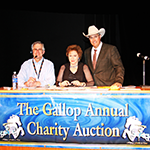After nearly a year of waiting, it’s finally here! Your new foal has hobbled into the world. Do you know which vaccinations your gangly new friend needs to help stay healthy?
“Starting a foal off on the right foot with preventive care to help protect it against equine disease actually begins with the broodmare,” says April Knudson, DVM, equine specialist for Merial’s Large Animal Veterinary Services. “With broodmares, it is best to give booster vaccinations approximately 30 days before foaling. This ensures the mare has a high level of antibodies in her colostrum, which are then passed on to her foal through the milk shortly after birth.”1
Assuming the mare has received the appropriate shots in the suggested timeframe, the American Association of Equine Practitioners (AAEP) recommends vaccinating the newborn foal for tetanus, Eastern/Western Equine Encephalomyelitis (EEE/WEE), rabies and West Nile virus (WNV).2 Most vaccination schedules begin when the foal is four to six months old and are given initially as a series, followed by annual revaccination.
“While horse owners may not be aware of instances of equine diseases in their communities, they do exist,” says Dr. Knudson. “Helping protect newborn foals against them is critical as they can be deadly or financially devastating,” she says.
Tetanus, which is fatal in at least 50 percent of the cases,3 can be caused by everyday manure, dirt or rust contaminating a puncture wound.3 EEE and WEE, also commonly known as sleeping sickness,4are two of the most common causes of equine encephalitis.5 Transmitted to horses by mosquitoes, EEE is fatal in 90 percent of the cases.6 WNV, identified in nearly 10,000 mosquito pools in 20117 and confirmed in 83 horses nationwide in 2011,8 is fatal in one out of every three cases.9 Rabies, the final disease for which the AAEP always recommends vaccination, is always fatal.10
“Because of the variability of climates and other conditions, we suggest horse owners work closely with their veterinarians to determine when the core vaccines should be given and which of the risk-based vaccines need to be considered,” says Dr. Knudson.
Once a foal receives his or her initial round of vaccinations, it’s important to keep them up to date notes Dr. Knudson. “Vaccinations should not be allowed to lapse as the horse then loses the immunity the vaccines were originally intended to provide and can be susceptible to disease. A timely vaccination schedule is an important part of an overall health care plan.”
Merial’s RECOMBITEK rWNV-EWT vaccine, which helps protect against WNV, EEE, WEE and tetanus, is safe for use in horses as young as four months of age.11 Horse owners should consult with their veterinarians regarding the specific dosing timetable. With an additional vaccination for rabies, foals will have received all core vaccinations as recommended by the AAEP.
For more information about the entire line of MERIAL®equine vaccines, visit www.equinewnv.com.
About Merial
Merial is a world-leading, innovation-driven animal health company, providing a comprehensive range of products to enhance the health, well-being and performance of a wide range of animals. Merial employs approximately 5,600 people and operates in more than 150 countries worldwide. Its 2011 sales were more than $2.8 billion. Merial is a Sanofi company.
For more information, please see www.merial.com.
®MERIAL and RECOMBITEK are registered trademarks of Merial Limited. ©2012 Merial Limited, Duluth, GA. All rights reserved. EQUIBGN1225 (03/12)
1Care of the Newborn Foal. Extension. Available at: http://www.extension.org/pages/10331/care-of-the-newborn-foal. Accessed December 8, 2011.
2 Vaccinations for Foals. American Association of Equine Practitioners. Available at: http://www.aaep.org/images/files/FoalVaccinationChartFinal022412.pdf. Accessed February 29, 2012.
3 MacKay RJ. Tetanus. In: Sellon DC and Long MT, ed. Eq Infect Diseases. St. Louis, Mo.:Saunders;2007:376-380.
4 Sleeping sickness in horses. Horses. Clemson Extension. March 1992. LL 48.
5 Kahn CM. Merck Veterinary Manual. 10th Edition 2010:1183.
6Eastern/Western Equine Encephalomyelitis. American Association of Equine Practitioners. Available at: http://aaep.org/eee_wee.htm. Accessed April 4, 2012.
7 United States Department of the Interior. United States Geological Survey. Available at: http://diseasemaps.usgs.gov/wnv_us_mosquito.html. Accessed April 4, 2012.
8United States Department of Agriculture. Animal and Plant Health Inspection Service. Available at: http://nsu.aphis.usda.gov/vs/nahss/equine/wnv/wnv_distribution_maps.htm. Accessed April 4, 2012.
9 West Nile Virus. American Association of Equine Practitioners. Available at: http://www.aaep.org/wnv/htm. Accessed April 4, 2012.
10 Rabies. American Association of Equine Practitioners. Available at: http://www.aaep.org/rabies.htm. Accessed April 4, 2012.
11 RECOMBITEK rWNV-EWT product label.









